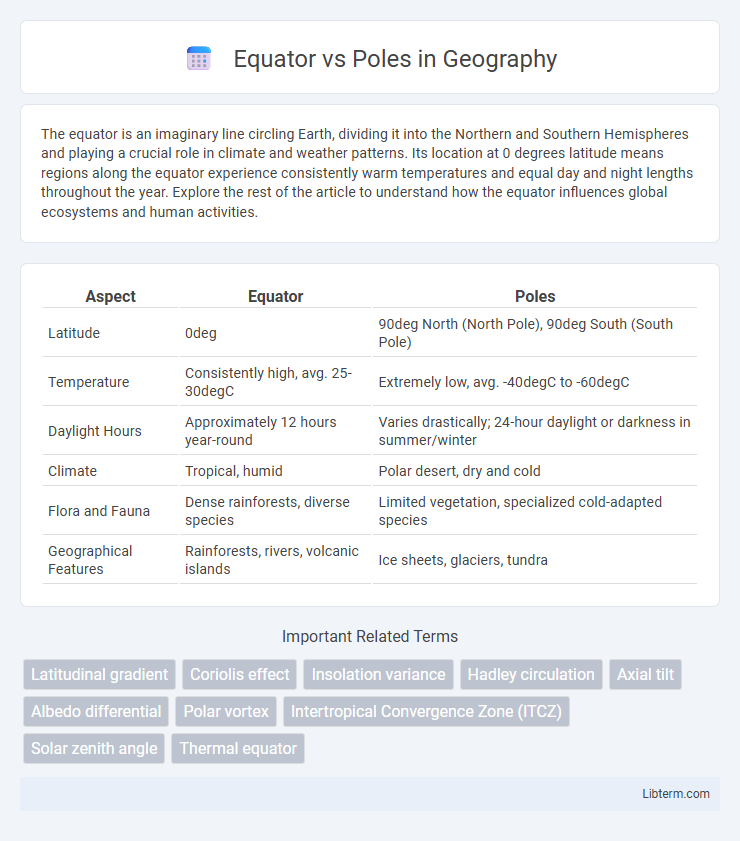The equator is an imaginary line circling Earth, dividing it into the Northern and Southern Hemispheres and playing a crucial role in climate and weather patterns. Its location at 0 degrees latitude means regions along the equator experience consistently warm temperatures and equal day and night lengths throughout the year. Explore the rest of the article to understand how the equator influences global ecosystems and human activities.
Table of Comparison
| Aspect | Equator | Poles |
|---|---|---|
| Latitude | 0deg | 90deg North (North Pole), 90deg South (South Pole) |
| Temperature | Consistently high, avg. 25-30degC | Extremely low, avg. -40degC to -60degC |
| Daylight Hours | Approximately 12 hours year-round | Varies drastically; 24-hour daylight or darkness in summer/winter |
| Climate | Tropical, humid | Polar desert, dry and cold |
| Flora and Fauna | Dense rainforests, diverse species | Limited vegetation, specialized cold-adapted species |
| Geographical Features | Rainforests, rivers, volcanic islands | Ice sheets, glaciers, tundra |
Introduction: Understanding the Equator and Poles
The Equator is an imaginary line circling Earth at 0 degrees latitude, dividing the planet into Northern and Southern Hemispheres. The Poles, located at 90 degrees north and south latitude, represent the extreme points of the Earth's axis. These reference points are fundamental in understanding Earth's climate zones, with the Equator experiencing consistent sunlight and warmth, while the Poles endure extreme cold and seasonal variations.
Geographic Location: Equator vs Poles
The Equator is an imaginary line located at 0 degrees latitude, dividing the Earth into the Northern and Southern Hemispheres, whereas the Poles are situated at 90 degrees north (North Pole) and 90 degrees south (South Pole) latitudes. Geographic locations at the Equator experience consistent day length and high solar radiation throughout the year, resulting in tropical climates and diverse ecosystems. In contrast, the Poles have extreme seasonal variations in sunlight, with polar nights and midnight suns, creating harsh, frigid environments characterized by ice caps and tundra landscapes.
Climate Differences: Tropical Heat vs Polar Cold
The Equator experiences consistently high temperatures year-round due to direct sunlight, resulting in a tropical climate characterized by intense heat and high humidity, promoting lush rainforests and diverse ecosystems. In contrast, the Poles receive minimal solar energy, causing extreme cold, icy landscapes, and permafrost, with temperatures often plunging below -40degC, creating harsh environments with limited vegetation and specialized wildlife. This stark climate difference drives unique weather patterns, biodiversity, and ecological dynamics between equatorial and polar regions.
Daylight Patterns: Sun at the Equator and Poles
The Equator experiences consistent daylight patterns with roughly 12 hours of sunlight and 12 hours of darkness year-round, due to the Sun's position directly overhead during equinoxes. In contrast, the Poles undergo extreme variations, with continuous daylight for about six months during summer (midnight sun) and complete darkness for six months in winter (polar night). This stark contrast results from the Earth's axial tilt, causing the Sun to remain above or below the horizon for extended periods at polar regions.
Biodiversity: Species Richness in Both Regions
The equator hosts the highest species richness due to its stable, warm climate and abundant rainfall, fostering diverse ecosystems like tropical rainforests. In contrast, the poles have significantly lower biodiversity, with species adapted to extreme cold and seasonal variations, such as polar bears and penguins. These environmental differences result in distinct patterns of species distribution and ecosystem complexity between the equatorial and polar regions.
Human Habitation: Population at the Equator vs Poles
Population density is significantly higher at the Equator due to favorable climate conditions, ample sunlight, and abundant natural resources that support agriculture and human settlements. In contrast, the Poles have sparse populations primarily consisting of indigenous peoples and scientific researchers, as extreme cold, limited sunlight, and harsh environmental conditions make permanent habitation challenging. Urban centers near the Equator, such as those in equatorial Africa, South America, and Southeast Asia, sustain millions, whereas polar regions maintain minimal human presence concentrated in research stations and small communities.
Cultural and Economic Activities
Cultural and economic activities vary significantly between the Equator and the Poles due to their distinct climates and environments. At the Equator, warm temperatures support agriculture, fishing, and vibrant cultural festivals tied to indigenous traditions, while economic activities include tropical crop production like coffee, cocoa, and bananas. In contrast, the Poles have limited economic activities focused on scientific research, sustainable tourism, and resource extraction such as fishing and mineral mining, with indigenous communities maintaining cultural practices adapted to extreme cold and isolation.
Environmental Challenges: Melting Poles and Deforestation
The Equator faces severe deforestation due to expanding agriculture and logging, leading to habitat loss and increased carbon emissions. The Poles experience accelerated ice melting driven by rising global temperatures, contributing to sea-level rise and disrupting polar ecosystems. Both regions are critical indicators of climate change, highlighting urgent environmental challenges that threaten biodiversity and global climate stability.
Scientific Research: Studies at the Equator and Polar Regions
Scientific research at the Equator focuses on biodiversity, tropical ecosystems, and atmospheric dynamics, leveraging consistent sunlight and warm temperatures to study plant growth and weather patterns. Polar research centers on ice core sampling, climate change indicators, and extreme microbial life, providing crucial data on global warming and Earth's past climate. Comparative studies between these regions enhance understanding of Earth's climate system, biogeochemical cycles, and adaptation strategies in extreme environments.
Conclusion: Key Contrasts and Global Significance
The Equator experiences consistently high temperatures and intense solar radiation, driving tropical biodiversity and climate patterns, while the Poles endure extreme cold and ice-covered landscapes, influencing global ocean circulation and climate regulation. These climatic contrasts create distinct ecosystems and play crucial roles in Earth's energy balance and atmospheric dynamics. Understanding Equator and Pole differences is vital for predicting climate change impacts and maintaining planetary health.
Equator Infographic

 libterm.com
libterm.com